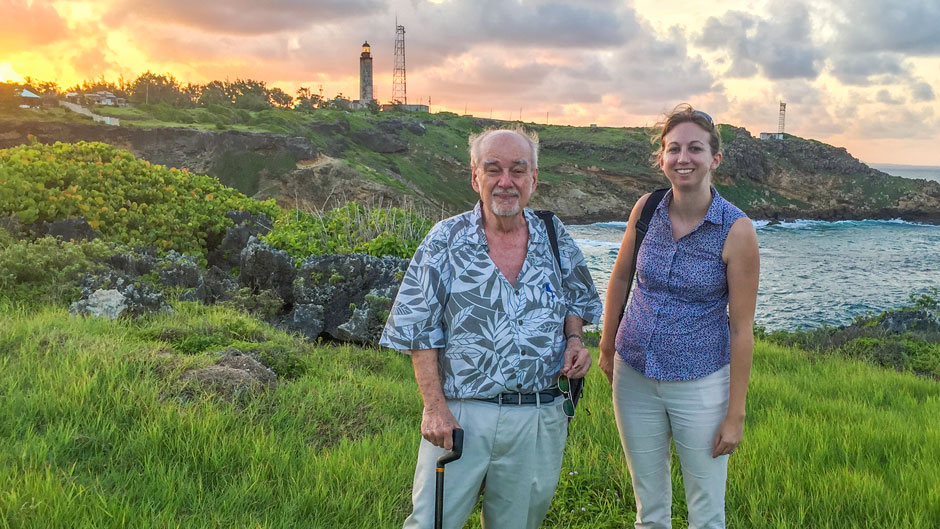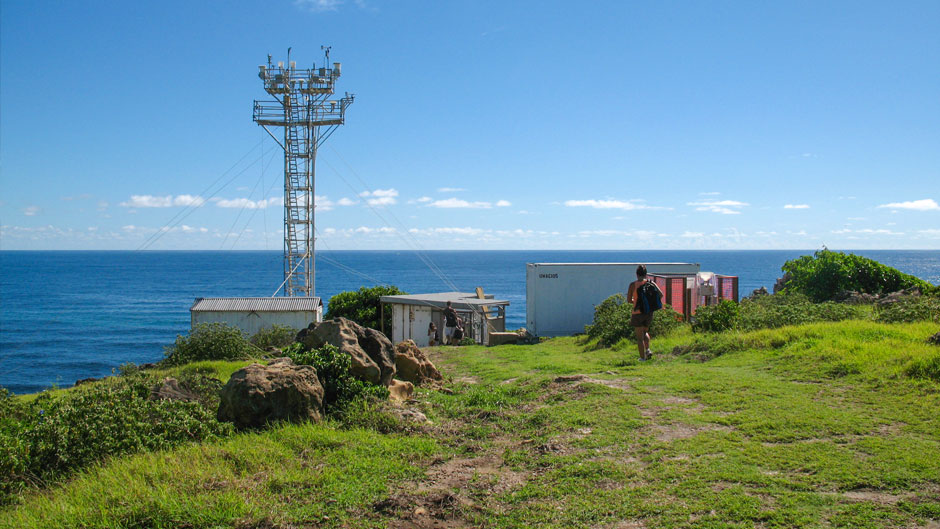Located inside two shipping containers on the eastern end of a Barbados promontory, the lab sports a cookie-cutter, box-shaped exterior that belies its high-tech innards.
When University of Miami researcher Haley Royer first saw the facility two years ago, she was a bit surprised by its humble façade.
But then, she walked inside and took a closer look at the site’s monitoring equipment.
Among the cutting-edge gadgetry she saw high-volume aerosol samplers, particle size analyzers, and a sun photometer that had arrived direct from NASA.
“Looking at the place from the outside, you wouldn’t think it’s the source of one of the world’s largest aerosol filter archives, or that it’s been absolutely vital to our understanding of African dust transport,” said Royer, a Ph.D. student at the University’s Rosenstiel School of Marine and Atmospheric Science. “But it just shows that sometimes all it takes to do good science is some creativity, ingenuity, and passion.”
For more than half a century, scientists at the Rosenstiel School’s Barbados Atmospheric Chemistry Observatory (BACO) have documented the summertime transport of Saharan dust particles across the Atlantic to the Caribbean Basin and South America, collecting the minute portions of matter in filters mounted on a 55-foot tower, analyzing them in labs, and studying their impact on clouds, climate, and air quality.
Though the facility is physically small, its reputation in the atmospheric science community is “larger than life,” said Cassandra Gaston, assistant professor of atmospheric sciences, who has operated the site for the past three years.
“When dust comes off the African continent, it travels across the ocean,” she said. “And once it reaches the Western Atlantic, Barbados is pretty much the first land mass it’s going to hit. So, that’s why our Barbados station is such a key monitoring site.”
She first learned of the station while conducting research as a doctoral student at the University of California, San Diego, Scripps Institution of Oceanography. She became inspired by the work of legendary atmospheric scientist and “father of dust” Joseph Prospero, the Rosenstiel School emeritus professor who, in 1971, established the facility at Ragged Point, the easternmost point on Barbados.
“Anyone in aerosol research knows about Joe and the station he built,” Gaston said. “When I was a Ph.D. student, I told my advisor I wanted to study tropical aerosols, and that I was going to be an aerosol specialist, kind of like Joe. Fast forward to me interviewing for a faculty position at the University of Miami and now running the station—it’s been a dream come true.”

Assistant professor Cassandra Gaston with emeritus professor Joseph Prospero at Ragged Point, site of the Barbados Atmospheric Chemistry Observatory.
The lab has been pivotal to Gaston’s work, helping her to obtain the critical data she needs to characterize the size and composition of aerosols and to quantify trace gases in the atmosphere.
“I’m very interested in how aerosols affect health and climate. And we’ve used this platform to look at how dust affects clouds, which is important for thinking about tropical cyclones,” Gaston explained. “We’ve used the facility to look at other sources of aerosols. There are natural emissions from ocean salts and organic material.”
Gaston also studies how aerosols produced by biomass burning can be a source of nutrients that fertilize ecosystems like the Amazon rainforest.
“We’re curious to know how human activities have perturbed that system,” she said. “Are we adding nutrients ourselves? Are we changing the distribution of these nutrients? How is that affecting ecosystem health? So, it’s important not just for thinking about ecosystem health and from a biological perspective, but it’s important because these ecosystems also sequester carbon dioxide out of the atmosphere. If they’re doing well, they can take more of the carbon dioxide out of the atmosphere than we’re putting in.”
Gaston oversees the BACO site from afar, keeping in close contact with site manager Edmond Blades. A microbiologist at Queen Elizabeth Hospital in Bridgetown, he has studied how pathogens that hitch a ride in dust coming from Africa might affect human health in Barbados, which has an unusually high occurrence of childhood asthma. “Those high rates of asthma have been thought to be related to dust transport,” Gaston said. “But no one’s been able to conclusively prove it.”
All told, she has made about six trips to BACO, far fewer than the several dozen taken by Prospero over the past five decades.
He remembers the trips well and recalls vividly how the small island nation in the Lesser Antilles has changed over the years, from the horse- and mule-drawn carriages that once dominated its roadways to the gas-powered vehicles of today.
“When we first went, there was electricity along the highways for streetlamps. But many of the locals didn’t have individual electrical lines or even water lines for that matter,” Prospero remembers. “A lot of the houses were prefabs with four sides and a roof, and they could literally build by the side of the road. But since then, the tourism industry has built up tremendously, and now it’s shocking when you go down there and see fields once covered by sugar cane now covered with hundreds of cement-block structures with air conditioning, electrical power, and water.”
All during that time, BACO has remained an island mainstay, with Prospero and researchers from other institutions using the site to conduct aerosol research of all kinds.
The station has also inspired groups of other scientific entities to set up shop on the island, all within earshot of BACO. In 1978, for example, the Advanced Global Atmospheric Gases Experiment established a research lab at Ragged Point, using BACO’s walk-up aluminum scaffold tower to make continuous measurements of chlorofluorocarbons and hydrochlorofluorocarbons that deplete the ozone layer.
And 12 years ago, the Max Planck Institute for Meteorology in Hamburg, Germany, established the Barbados Cloud Observatory on a bluff just south of BACO, studying shallow trade wind clouds to elucidate how they might change in response to global warming.
Still, none of those other facilities are quite like BACO.
“There are very few operations that have developed the long record of aerosol measurements like we have,” Prospero said. “In recent years, other people have started to measure dust, not necessarily from stations like ours, but using remote sensing techniques, which doesn’t give you composition and aerosol physical characteristics. So, we’re still rather unique in that respect.”
Scientists the world over can attest to that. And some are students like Royer, the Rosenstiel School doctoral candidate who conducted field research at BACO during two of the coldest winter months, January and February, of 2020. “My initial goal was to study the tropical Atlantic when dust is not present in order to understand controls on cloud formation during a time period that is unaffected by dust,” Royer explained.
But during those two winter months at Ragged Point, unusually high concentrations of dust and smoke that were on par with summertime levels hit the site, causing Royer to shift her research focus.
“I started looking at the impact of dust and smoke particles on both cloud formation and nutrient transport in the tropical Atlantic,” she said. “And BACO was absolutely essential in conducting this research as its location is situated well-within the trade winds that carry Saharan dust across the Atlantic to the Caribbean during the summer and is theoretically unaligned with the trade winds during January and February, when they shift south. This difference in alignment allowed us to show that dust and smoke transport are still relevant in the Caribbean even when the Caribbean theoretically shouldn’t receive dust at all.”
Now, Gaston wants to upgrade the Ragged Point facility. She has submitted a grant proposal for funding that will allow the site to yield more “on-the-fly data rather than having to process [aerosol] filters,” she said. “We want to foster more research in the scientific community. That’s the vision we have for it.”

